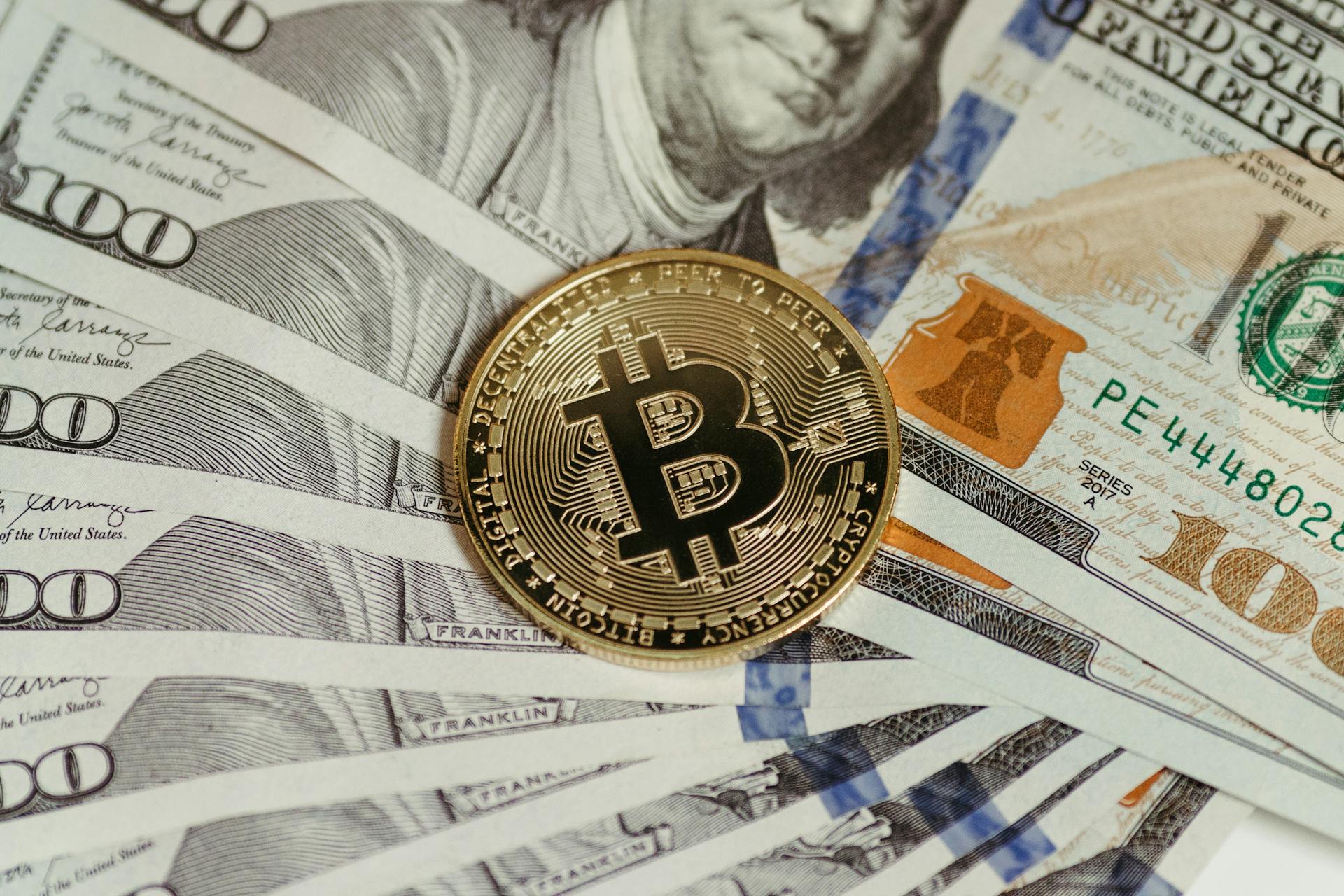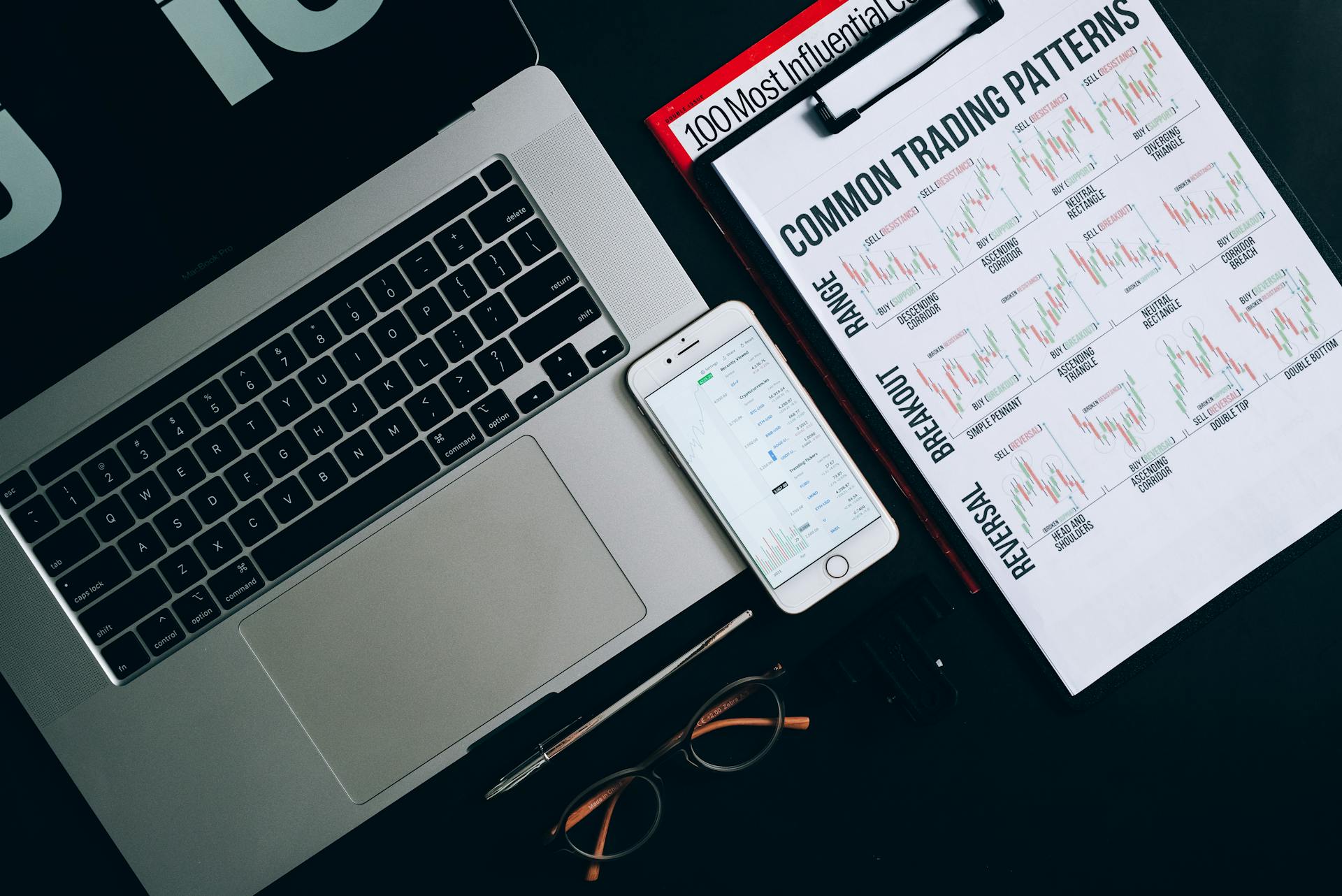
High-frequency trading (HFT) algorithms are computer programs that execute trades at incredibly fast speeds, often in a matter of milliseconds. These algorithms can analyze vast amounts of market data and make decisions faster than human traders.
HFT algorithms typically employ complex mathematical models and statistical analysis to identify profitable trading opportunities. By leveraging high-performance computing and low-latency networks, HFT algorithms can react to market changes in real-time.
The main goal of an HFT algorithm is to maximize profits by exploiting small price discrepancies in the market. This is often achieved through the use of sophisticated technical indicators and machine learning models.
A well-designed HFT algorithm can execute thousands of trades per second, making it a highly effective way to profit from market volatility.
You might like: Reset Hinge Algorithm
How It Works
High-frequency trading (HFT) is an automated form of trading that uses algorithms to identify trading opportunities. These algorithms are sophisticated and can process vast amounts of data in real-time.
The trader's platform sends orders to the exchange's matching engine within microseconds, thanks to the co-location facility where the trader's server is located in close proximity to the exchange's servers. This reduces latency and allows for lightning-fast execution.
The algorithm continuously monitors real-time market data feeds, including price movements, order book changes, and trading volumes for the selected stocks. It quickly identifies patterns, trends, and potential arbitrage opportunities.
Once the algorithm detects a price difference that meets its predefined criteria, it triggers an immediate buy order for the undervalued stock and a corresponding sell order for the overvalued stock. This is done in fractions of a second, allowing the trader to capture the price difference and make a profit.
The trader repeats this process across multiple trades throughout the trading day, executing a high volume of trades with minimal time lag. This makes small profits on each trade that collectively add up over the course of the day.
The algorithm's rapid execution ensures that the trader can capture the price difference and make a profit on the arbitrage opportunity. This is the key to success in HFT trading.
For your interest: Universal Portfolio Algorithm
Here's a breakdown of the steps involved in HFT trading:
- Algorithmic Strategy: The trader develops a sophisticated algorithmic trading strategy that takes advantage of price discrepancies between two related stocks.
- Data Analysis: The algorithm continuously monitors real-time market data feeds and identifies patterns, trends, and potential arbitrage opportunities.
- Instant Decision: The algorithm triggers an immediate buy order for the undervalued stock and a corresponding sell order for the overvalued stock.
- Lightning-Fast Execution: The orders are executed at ultra-fast speeds, with the trader's platform sending the orders to the exchange's matching engine within microseconds.
- Profit Capture: The trader captures the price difference and makes a profit on the arbitrage opportunity.
Benefits and Advantages
High-frequency trading (HFT) has become a dominant force in the market, and its benefits are worth exploring. HFT has reduced the bid-ask spreads to near zero, eliminating excessively small bid-ask spreads that institutions used to profit from.
A study in Canada found that the spread paid by retail investors increased by 9 percent, while charges to institutional traders rose 13 percent, after HFT fees were implemented. This highlights the impact of HFT fees on market dynamics.
HFT has also improved overall market liquidity, reducing the gap between prices of bid and ask orders. This makes markets more efficient and beneficial for traders.
Research has shown that introducing fees on HFT led to increased bid-ask spreads, emphasizing the role of HFT in maintaining narrower spreads. This is a crucial aspect of HFT's benefits.
Here are some key benefits of HFT:
- Rapid execution of trades within seconds
- Improved market liquidity
- Narrower bid-ask spreads
These benefits are a result of HFT's ability to execute trades quickly and efficiently, contributing to better market liquidity and narrower bid-ask spreads.
Market and Trading
High-frequency trading, or HFT, is a key player in the cryptocurrency market. It works by using algorithms to analyze crypto data and facilitate a large volume of trades at once within a short period of time, usually within seconds.
HFT market makers aim to profit from the spread between the bid and ask prices, responding quickly to changes in supply and demand. This strategy involves continuously buying and selling securities to provide liquidity to the market.
In the cryptocurrency market, HFT market makers can make a significant impact by responding quickly to price changes. They can execute trades in a matter of seconds, giving them a competitive edge.
HFT market makers focus on making profits from the spread between bid and ask prices, rather than trying to predict future price movements. This approach allows them to take advantage of small price differences and generate consistent returns.
Algorithms and Strategies
High-frequency trading (HFT) relies heavily on complex algorithms that analyze market data to identify small price discrepancies. These algorithms are designed to execute trades within milliseconds to capitalize on tiny differences.
Machine learning algorithms and artificial intelligence are used by some HFT firms to predict market movements, identify trading opportunities, or optimize existing trading strategies. This allows them to stay ahead of the competition and make more informed decisions.
Some common HFT strategies include market making, index arbitrage, and statistical arbitrage. Market making involves providing liquidity by continuously buying and selling securities, capturing the spread as profit. Index arbitrage, on the other hand, exploits price differences between an index and its futures or underlying components.
Here are some key HFT strategies:
- Market Making
- Index Arbitrage
- Statistical Arbitrage
- Triangular Arbitrage
- Latency Arbitrage
- Event Arbitrage
- Order Flow Prediction
- Momentum/Ignition Strategies
- Quote Stuffing
- Flash Orders
- Spoofing and Layering
- VWAP Tracking
- Regulatory Arbitrage
- TWAP Strategy
- Order Book Imbalance
- Mean Reversion Strategies
- Tick Data Strategies
- Microstructure Noise Exploitation
- Co-Location and Proximity Hosting
- Signal-Based Strategies
- Machine Learning and AI-Based Strategies
- Dark Pool Liquidity Detection
- Cross-Market Arbitrage
- Liquidity Detection
- Rebate Arbitrage
- Iceberg Order Detection
- Pair Trading
- Volume Prediction
- Latency Arbitrage Across Data Centers
- Microsecond Trading Strategies
- Regulatory Latency Arbitrage
- Sentiment Analysis Trading
- Weather-Based Trading
- Quantum Trading
- Intermarket Sweep Orders (ISOs)
- Dividend Arbitrage
- ETF Creation/Redemption Arbitrage
- Options-Based Volatility Strategies
Momentum/Ignition Strategies involve identifying and following early signs of market movement in a particular direction and then trading aggressively in that direction. These strategies often lead to a "momentum ignition" where the movement becomes self-sustaining for a short period.
Some HFT strategies exploit flaws in data and algorithms to gain a competitive edge. Latency Arbitrage, for example, takes advantage of delays in data dissemination, while Order Flow Prediction leverages the predictability of algorithmic trading patterns.
You might enjoy: Currency Trading Strategy
Risk and Control
Risk and Control is a crucial aspect of High-Frequency Trading (HFT) algorithm. System administrators can configure risk limit checks to apply to a specific user, group of users or all users.
Risk checks can be configured for various custom-defined categories, allowing for tailored risk management. For example, one can define certain risk check rules to suit their trading strategy.
The system can detect when traders attempt to send large market orders to the open markets rather than to the broker's desks or algorithms and warns traders of the potential risk. This helps prevent potential losses due to excessive trading.
An administrator can use various methods for risk check calculations, including percentage, absolute, Bps, percentage of spread, percentage of price or tick, and price away checks. These methods allow for a range of risk assessment approaches.
Here are some key risk control features:
- Risk limit rules can be assigned to specific instruments, all instruments or any instrument within specified Category.
- The system ensures the total number of orders sent over a specific time interval does not exceed a pre-set level.
- It also ensures the total amount traded over a specific interval does not exceed a pre-set level.
- Validates order limit price against some reference price.
- Checks the size of the order against the percentage of the instrument ADV.
Regulatory Arbitrage
Regulatory Arbitrage is a strategy that involves taking advantage of differences in regulations across regions or markets. Algorithms are designed to spot and exploit these gaps.
This approach can be particularly lucrative for high-frequency trading firms. They can use complex algorithms to identify and capitalize on regulatory disparities.
The key to successful Regulatory Arbitrage is having access to real-time data and advanced analytics. This allows firms to quickly spot regulatory gaps and make trades before others do.
Regulatory Arbitrage can be a high-risk strategy, and firms need to be aware of the potential pitfalls. However, for those who can execute it effectively, the rewards can be substantial.
If this caught your attention, see: Best Brokerage Firms for Day Trading
Risk Control Features
Risk Control Features are designed to help system administrators configure risk limit checks that can be applied to specific users, groups of users, or all users. This can be done for various custom-defined categories.
Risk checks can be configured to apply to specific instruments, all instruments, or any instrument within a specified category. For example, one can define certain risk check rules.
Risk limit rules can be assigned to specific instruments, all instruments, or any instrument within a specified category.
On a similar theme: What Is Risk Parity
The system ensures the total number of orders sent over a specific time interval does not exceed a pre-set level. This helps prevent over-trading and potential losses.
Risk checks can also ensure the total amount traded over a specific interval does not exceed a pre-set level. This is a crucial feature for traders who need to manage their exposure.
The system validates order limit price against some reference price. This helps prevent traders from placing orders at unfavorable prices.
In addition, the system checks the size of the order against the percentage of the instrument's Average Daily Volume (ADV). This helps prevent traders from placing large orders that may impact the market.
Intraday buys minus sells implies that calculation is done based on shares or contracts. For example, an Open Long Position may not exceed 1,000,000 shares.
Here are some common risk control features:
- Percentage – order size check against ADV
- Absolute, Bps, Percentage of Spread, Percentage of Price or Tick – units for Single Order
- Price Away checks
The system also issues a warning when the risk limit level is approached. This helps traders take action to reduce their risk exposure.
InfoReach detects when traders attempt to send large market orders to the open markets rather than to the broker's desks or algorithms and warns traders of the potential risk. This is a valuable feature for traders who need to manage their risk exposure.
On a similar theme: How Do Bond Traders Make Money
Technology and Infrastructure
Technology and Infrastructure is a crucial aspect of HFT trading algorithms. Co-location, where servers are placed physically close to the exchange's servers, is a key enabler for many HFT strategies.
This practice, also known as proximity hosting, reduces data transmission time, making it possible for HFT algorithms to execute trades at incredibly fast speeds.
The goal of co-location is to minimize latency, which is the delay between the time a trade is executed and the time it is confirmed.
By reducing latency, HFT algorithms can react faster to market changes, giving them a significant advantage over other traders.
Recent Developments and Trends
High-frequency trading has become a major player in the world of finance, and its impact is being felt across the globe. The introduction of HFT tactics has changed the landscape for traders, investors, and corporations.
Recent years have seen a dramatic shift in the world of trading, driven by the rise of high-frequency trading. The world of trading has undergone a dramatic shift in recent years.
One of the key developments in HFT is the use of complex algorithms to execute trades at incredibly high speeds. These algorithms can process and execute trades in a matter of milliseconds.
The introduction of high-frequency trading has also led to increased volatility in the markets, making it more challenging for investors to navigate. This has led to a significant increase in the number of market participants.
Types of Orders and Trades
Market orders are a type of order that allows traders to buy or sell a security at the current market price.
Limit orders are used to buy or sell a security at a specific price or better, and can be placed above or below the current market price.
Stop-loss orders are used to limit potential losses by automatically selling a security when it falls below a certain price.
A stop-limit order is a combination of a stop-loss and a limit order, allowing traders to set both a stop price and a limit price.
In the context of HFT trading algorithms, traders often use these types of orders to execute trades quickly and efficiently.
Take a look at this: Stock Order Book
Frequently Asked Questions
Is HFT trading profitable?
Yes, high-frequency trading (HFT) can be profitable, as it allows for quick execution of trades and significant profits through bid-ask spreads. However, its profitability depends on various market conditions and strategies.
What is a HFT bot?
A HFT bot is a computer program that rapidly executes many trades in a short time to profit from small price fluctuations. It relies on speed and precision to make tiny profits throughout the day.
Featured Images: pexels.com


